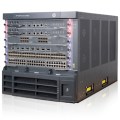 HP’s networking business has made a big deal of its support for OpenFlow since last year, and this week it advanced its case by introducing its first core switch that support the software-defined networking (SDN) enabling protocol.
HP’s networking business has made a big deal of its support for OpenFlow since last year, and this week it advanced its case by introducing its first core switch that support the software-defined networking (SDN) enabling protocol.
The company introduced five new or upcoming offerings in its FlexFabric family of datacenter switches, including its new flagship, the FlexFabric 12900 series, a switch the company says scales twice as far as rival Cisco’s flagship Nexus 7000 switch.
With the new products, the company now has some 40 switches that support OpenFlow, with some 20 million OpenFlow-capable network ports already available in the market. It also is on track to become the first to market with support for OpenFlow 1.3 when the new products debut.
Along with the 12900 series, HP also introduced the FlexFabric 11908 datacenter aggregation switches, which support for up to 384 10 GbE or 64 40GbE ports and the HSR 6800 router series, with 32 10GbE ports.
On the software side, the company introduced the FlexFabric 5900v Virtual Switch, which aims to automate network changes when virtual machines move from server to server, and the HP IMC SDN Manager, a software console for configuration, monitoring, and policy management from branch to datacenter networks.
“It takes the simplifications that SDN delivers to the next level with automation,” said Kash Shakih, director of marketing for HP Networking.
The company also touts its HP Intelligent Management Center (IMC) Virtual Application Network Resource Automation Manager software as a way for customers who haven’t jumped in to SDN or OpenFlow to get some of the automation benefits associated with the newer technology.
The case for software-defined networking, and OpenFlow in particular, is strong on paper. Going with an SDN infrastructure promises to make the datacenter network “flatter,” more automated, and better suited to the heavily virtualized workloads typically thrown at them. The promise is that enterprises will be able to future-proof their network infrastructure and introduce greater scale and more functionality without having to rip and replace. But while the networking industry is gung-ho about SDN, many datacenter operators are taking a wait-and-see approach. Shakih sees that as an education opportunity for channel partners.
“It’s an opportunity for our partners to become a thought leader with their customers by providing the whole SDN solution,” he said.
HP has long touted itself as “a needed alternative” to Cisco in the networking arena, and the 12900 gives it a solid story at the core of the datacenter network for the first time, a change that may make it more attractive to solution providers with growing datacenter businesses.












1 comment for “HP Networking Goes SDN to the Core”